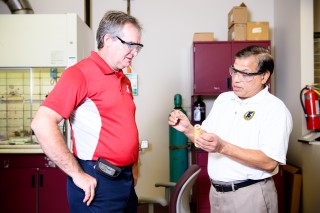UA Researchers Develop Novel Method for Making Electrical Cellulose Fibers

The University of Alabama Drs. Scott Spear, left, research engineer, and Anwarul Haque, associate professor of aerospace engineering and mechanics, discuss their work while examining a spool of cellulose fiber with polypyrrole in a lab at The University of Alabama.
The new method of crafting the fibers could open up normally flimsy materials, such as cotton, to conduct electricity in technologies normally reserved for stronger fibers.
The process could also make conductive polymer composites, as they are called, less expensive to prepare with fewer harmful environmental side-effects.
Conductive polymers have wide-ranging physical and electrical properties. They are used in applications from organic transistors, coatings for fuel cells, smart textiles and electromagnetic shielding.
However, the process for making conductive polymer composites such as electrically-conductive cotton, wool or nylon is difficult since the mechanical properties, or its strength, are weakened during preparation.
The inventors of the patent are Dr. Scott Spear, a research engineer with UA’s Alabama Innovation and Mentoring of Entrepreneurs, known as AIME; Dr. Anwarul Haque, associate professor of aerospace engineering and mechanics; Dr. Robin Rogers, the Robert Ramsay Chair of Chemistry at UA and director of UA’s Center for Green Manufacturing; Dr. Rachel Frazier, a research engineer at AIME, and Dr. Dan Daly, director of AIME.
The UA researchers worked with polypyrrole, a particularly useful conductive polymer that can be difficult to bind to fibers. To turn the base chemical, pyrrole, into a polymer that can conduct electricity, polypyrrole, it is put through a chemical process using methanol and the iron-containing ferric chloride. Methanol, sometimes called wood alcohol, is a volatile organic compound that is highly toxic to humans.
Polypyrrole made through this method, though, does not stick well to fibers such as cotton. To bind the fibers with the polypyrrole they are dipped in an acidic solvent that degrades the fiber to increase the surface area so the polypyrrole can stick. This degradation, though, weakens the fiber.
The patented method developed at UA would retain much of the fibers strength by using ionic liquids, which are liquid salts at or near room temperature with low volatility that carry an electric charge. The ionic liquids do not degrade the fibers as much, and the process creates nanostructures that result in a stronger composite material. It also makes the composite better at conducting electricity.
The ionic liquids cannot only be used to fabricate conductive polymer composites, but can be used in place of other solvents to create the polypyrrole.
“We get a better absorption of iron on a cotton or nylon fiber in the presence of ionic liquids,” Spear said.
The process is potentially cheaper and environmentally cleaner since using ionic liquids results in much less harmful by-products from the chemical reaction.
“A lot of effort has been made into making cellulose fibers conductive through chemical methods that, from a manufacturing standpoint, are not environmentally friendly,” Haque said. “Our process does away with the use of methanol through the novel use of ionic liquids, which, by their very nature, have a low volatility that essentially eliminates environmental release pathways exhibited by methanol.”
The patented process could impact what are known as smart textiles, clothing often with traditional electronic features woven into the fabric. The UA-developed method, though, could make it easier for the clothing itself to transmit the electric signals. Smart textiles could be employed in protective clothing, medical textiles and other applications foreseen in military, sports, medical, industrial as well as consumer products
“In the future, cloth or fabrics will not only protect the wearer, but also have intelligent built-in features, such as multifunctional sensors or computing devices,” Spear said. “Conductive cotton fiber represents an important component in the development of smart materials for a variety of military, industrial and commercial applications.”
This research is funded by the National Science Foundation.
U.S. Patent Designated No. 8,784,691 was granted July 22 and claims conductive composites prepared from ionic liquids, compositions for preparing the composites and methods of making and using the composites.
Contact Information
Chris Bryant
Public Relations Assistant Director
cbryant@ur.ua.edu
Phone: 205-348-8323
Media Contact
More Information:
http://uanews.ua.edu/All latest news from the category: Materials Sciences
Materials management deals with the research, development, manufacturing and processing of raw and industrial materials. Key aspects here are biological and medical issues, which play an increasingly important role in this field.
innovations-report offers in-depth articles related to the development and application of materials and the structure and properties of new materials.
Newest articles

High-energy-density aqueous battery based on halogen multi-electron transfer
Traditional non-aqueous lithium-ion batteries have a high energy density, but their safety is compromised due to the flammable organic electrolytes they utilize. Aqueous batteries use water as the solvent for…

First-ever combined heart pump and pig kidney transplant
…gives new hope to patient with terminal illness. Surgeons at NYU Langone Health performed the first-ever combined mechanical heart pump and gene-edited pig kidney transplant surgery in a 54-year-old woman…

Biophysics: Testing how well biomarkers work
LMU researchers have developed a method to determine how reliably target proteins can be labeled using super-resolution fluorescence microscopy. Modern microscopy techniques make it possible to examine the inner workings…





















